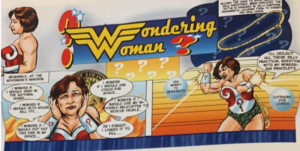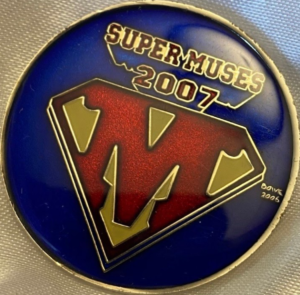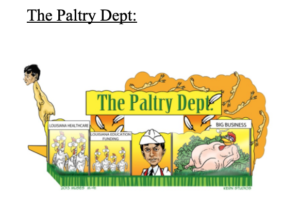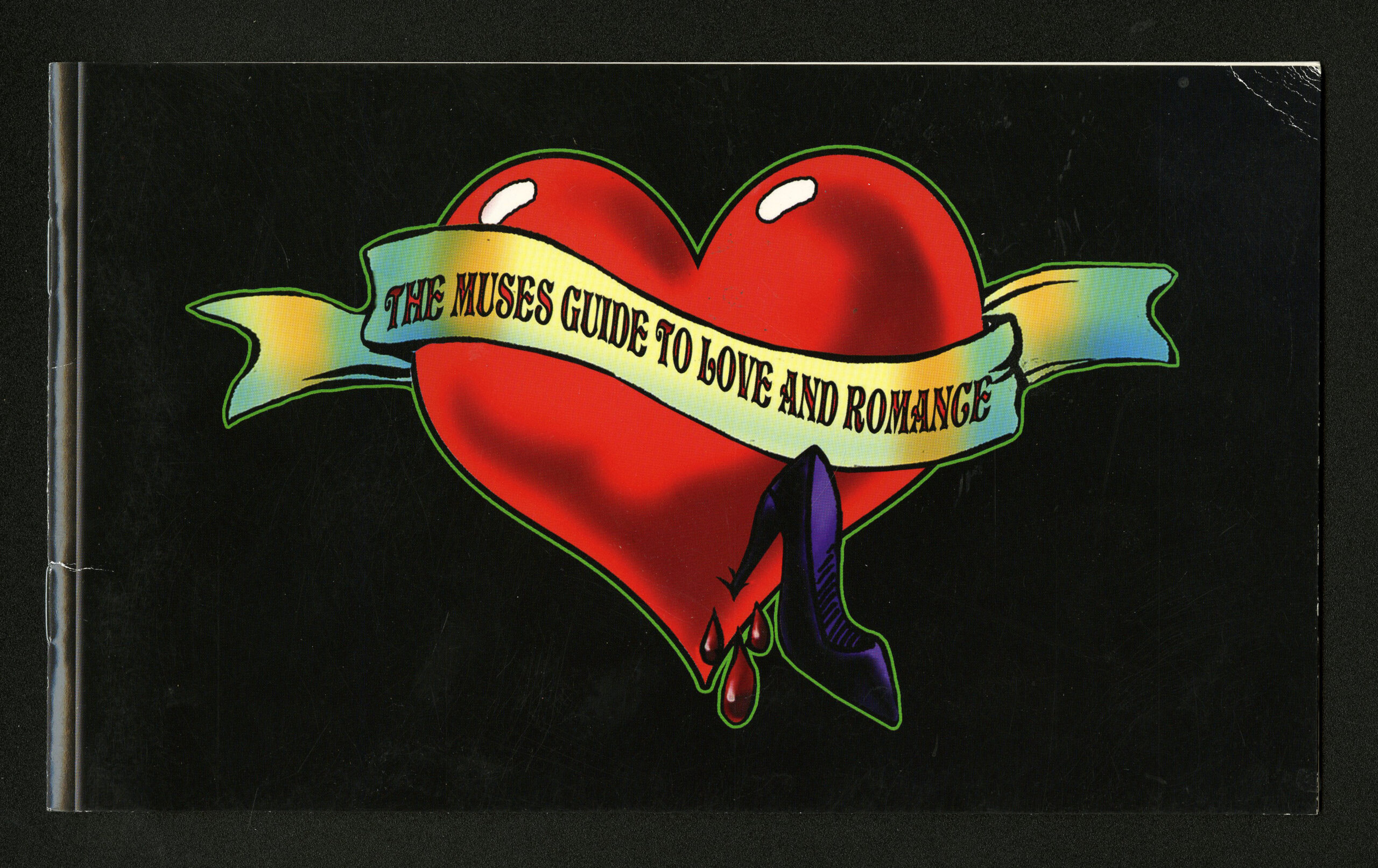“Happy is he whom the Muses love: sweet flows speech from his lips.” (Homeric Hymm to the Muses and Apollo, 1).
The Krewe of Muses was founded in 2000; even though it was not the first all-female group to be intertwined with Mardi Gras, they were the first all-female krewe to parade at night. As well, Muses’ parade date is closest to Mardi Gras out of all the all-female K\krewes, which also establishes their prestige and elite status. Recognized for their extravagant throws of handcrafted, glittered shoes, the Krewe of Muses’ membership has grown to over 1,500 members since their first parade in 2001. This highly respected all-women krewe has exploded with recognition and popularity.
The krewe’s name originates from Greek mythology; the Muses were the nine daughters of Zeus. The Muses were the patrons of the arts and sciences, who were inspirations for musicians, artists, poets, writers, and many more,
“…the nine Muses are goddesses of the various arts such as music, dance, and poetry and are blessed not only with wonderful artistic talents themselves but also with great beauty, grace, and allure. Their gifts of song, dance, and joy helped the gods and mankind to forget their troubles and inspired musicians and writers to reach ever greater artistic and intellectual heights.” (Cartwright).
The Adventures of Supermuse Comic Book
by Graham Pierson
The Krewe of Muses is a relatively new Mardi Gras krewe. It was founded in 2000 with the first parade being in 2001. The Krewe is made up of all women and has grown to be one of the most popular Krewes that run parades today. Every krewe has a signature item that they throw to eager onlookers. Muses throws shoes, very fancy high heels to be exact. Muses members hand craft the shoes and they have turned into some of the most sought after throws on Mardi Gras day. Their all female membership challenges the traditional ideas of the elite, male-only krewes. Muses is heavily involved in the community as their rise to prominence coincided with the rebuilding following Hurricane Katrina.

2007 Krewe of Muses comic book, “The Adventures of Supermuse”, Carnival collection, LaRC-900, Tulane University Special Collection, Tulane University, New Orleans, La
The “Adventures of Supermuse” comic chronicles the human embodiment of the overarching goals of the Krewe of Muses. The comic sees the main character try her best to improve the situation the city faced in the aftermath of Hurricane Katrina. One of the ways the krewe tries to accomplish their goal is through the intervention in politics. Supermuse didn’t have much luck in her conversations with powerful politicians. Each person Supermuse interacts with sports a superhero nickname that highlights their shortcomings. Based on the comic, Muses definitely has a love/hate relationship with politics but they rely on it to accomplish their goals. Supermuse highlights this relationship throughout the comic. Her visit to the Governor’s mansion is a good example. The Governor, who is dubbed “Wondering Woman,” is obviously an interpretation of the Governor of Louisiana at the time, Kathleen Blanco. Their interaction consists of Blanco questioning every decision and not being able to help the immediate situation. Supermuse’s exchange with a local political figure probably mirrors the Krewe’s attitude toward those actually in power.

Float design, 2007 Krewe of Muses parade (“Supermuse”), Carnival collection, LaRC-900, Tulane University Special Collection, Tulane University, New Orleans, La
Another one of Muses’ main goals is to challenge the ideas of a traditional, male only, Mardi Gras Krewe. The tradition of Mardi Gras krewes has been a controversial topic of conversation recently. Their roots are undeniably rooted in racism, classism and patriarchy. The most selective of the krewes were always made up of the most wealthy white men in the city. Because krewes are private, if they just say they don’t deny people based on race, they can get away with it. The tradition of giving away a member’s daughter to search for a husband also has problematic meanings. It demonstrates a control that these men have over the women in their life. Muses doesn’t allow any men for one, and they accept all races. However they do consist primarily of upper/middle class women. Supermuse is a strong female superhero, something that isn’t nearly as common as males superheroes. The comic shows that women can make an impact too, something that the Muses want us to know.
The all female Krewe of Muses has evolved a great deal in its short existence. Hurricane Katrina brought great devastation and Muses was instrumental in the revitalization of the city. “The Adventures of Supermuse” provides some insight as to what the Muses are all about. Their political leads help them establish their goals for society as a whole.
Muses and the Doubloon
by Matt Bihm

2007 Super Muses Doubloon, Carnival collection, LaRC-900, Tulane University Special Collection, Tulane University, New Orleans, La
Muses originated from Greek mythology and was named for the 9 daughters of Zeus. First established in the early 2000s, the Krewe of Muses is recognized as the first all-female krewe to parade at night in uptown New Orleans. The vision of Muses was to represent New Orleans and celebrate the culture of the community. Since inception, it has grown to over 1,500 members and to this day there is an extensive waiting list to join. Women parades started in New Orleans in 1941, over a century after the first float-based parade was recorded. Additional female krewes formed in the late 20th century; however, their parades were dismissed as inferior to male parades. The women of Muses had a clear vision of how gender affects Mardi Gras and they made a conscious effort to challenge elite male krewes. Muses helped breathe new life into New Orleans carnivals by transforming local traditions, designing satirical floats, and creating signature hand-decorated feminine throws. It is also known that nighttime parades are considered more prestigious than day parades, which has made the Krewe of Muses a special, all-female Mardi Gras celebration. Through playfulness, their themes celebrate feminine ideals and encourage the women’s power movement. They also devote themselves to community philanthropy. Over the years, they have expanded their community involvement by including students, senior citizens, and people in rehabilitative environments to help create their popular throws.
A throw that has been around since the late 1950s are doubloons. These were made because krewes were in search of a new throw that would be memorable, functional, and unique for Mardi Gras krewe members to use. “Mr. H. Alvin Sharpe, who was an artist in the New Orleans area, approached the Krewe of Rex organization with the idea of developing a coin made from aluminum, as previous throws were made from wood and aluminum was not as heavy as gold or silver. The captain of the Krewe of Rex, Mr. Fenner was interested in the new aluminum throw, but was concerned about the safety of parade goers. Mr. Sharpe demonstrated their safety by tossing a bag of blank doubloons at Mr. Fenner, which caused no harm. The Rex organization was excited about this new throw, placed a large order, and they were a hit at carnival” (Doubloon). Numerous Mardi Gras krewes have utilized this throw in their parades and many have minted their doubloons to symbolize their organization. They vary in color and typically have the year and theme listed, which changes each year. Many of the elite organizations also have “keepsake” doubloons created each year, which are made from a heavier and more valuable metal. These doubloons are typically given to family and close relatives as mementos.
The artifact presented here is a doubloon from the 2007 parade titled “Super Muses.” This keepsake doubloon has a symbol similar to Superman, but with a twist. Instead of a “S”, it has a “M” for Mueses. This theme was created to represent the aftermath of the floods of Hurricane Katrina and the cleanup that followed. “The average New Orleans woman and member of the Krewe of Muses waded through toxic soup to her New Orleans home. She became “Super Muse ” and had the power to lift tons of debris. Super boots gave her the ability to fly over the political red tape in order to save New Orleans, while meeting a variety of other superheroes and supervillains along the way (Muses).” This particular doubloon is a unique piece with its gold anodized body and blue face with the design of that year’s theme.
In order to keep up with the elite male krewes, Muses creates a unique doubloon each year that is highly sought after and treasured by many parade revelers. This 2007 doubloon does not disappoint as it is well designed, reflects the high standards and quality of Muses, and symbolizes the strength of this powerful all-woman krewe.
Behind the Scenes of the Muse Krewe
by Eliana Martini
Prior to the year of 2000, there was not necessarily a predominant, strong female krewe to make their way through the Mardi Gras festivities. The parades and parties were dominated by mostly white men that were part of exclusive organizations closed off to many in the community. With intentions to combat the sexism that was evident in the traditional Mardi Gras, the Krewe of Muses was founded in the year 2000 and first debuted their parade in 2001. Right off the bat, Muses had a grand impact on the New Orleans and Mardi Gras community, and have since grown to consist of over 1500 members – so many that they actually have had to temporarily postpone membership availability, perfectly demonstrating their intense popularity (Krewe of Muses). Over the years, they have grown to be incredibly well known for their satirical floats and unique throws: custom made, embroidered shoes that are one of the most sought after throws in the entire Mardi Gras party.
Leading up to the year 2000, many shifts were occurring in the feminist movement – particularly in the beginning of the 1970’s, during which there was a large shift in what is known as second wave feminism. Second wave feminism essentially perpetuated a new form of the movement and was highly forward thinking in terms to how women were viewed in society (Grady 2018). It then is evidently fitting that only years later, the Krewe of Muses stepped into the light, taking charge and becoming the largest female krewe involved in Mardi Gras’ infamous traditions.
In 2013, the krewe took on the theme of “Makin’ Groceries Muses Style.” Their parade consisted of numerous floats, all of which were variations on aisles or products one would find in a grocery store. The artifact in the archives was a large pamphlet that held cartoons/caricatures that illustrated and embodied each individual float’s main focus. Being that it was mirroring the “layout” of a grocery store, they had “aisles”such as: “The Whine Department,” “Mr. Clean and the Magic Erases,” “Dairy,” “Fresh Meat,” “The Paltry Dept.,” “The Serial Dating Aisle,” and the “Expired Goods Aisle” (Krewe of Muses). These specific floats highlight the wide variety of topics the Muses chose to poke fun at, in turn demonstrating their values and representing what their krewe stands for across the board. As per usual, they took on several subjects of possible controversy, general occurrences in the New Orleans community, problems such as sexism, and political matters that they presented in a satirical manner that put an uplifted, comical spin on the topics. Throughout this parade, they touched on and mirrored the hypersexualization of women in society, took obvious cracks at men in a similar way to how men often scrutinize women when looking for a prospective partner, teased at ideas such as botox, celebrities, and men’s “fear” of feminine products, and focused on bringing together those in the community who were otherwise excluded (particularly women and those who identify as LGBTQ+).
Overall, this specific presentation put on by the Krewe of Muses in 2013 highlights the faults in political decisions, mocks sexism, and takes hold on derogatory views of women in a way that gives the power back to them. Given the progress and immense impact that they have made over the past 20 years, they will continue to flourish and grow. Their development undoubtedly goes hand in hand with the feminist movement itself, as “feminism is far from over,” despite the advancements and changes that have occurred in our societies over the many years (Cobble et al. 230).





Krewe of Muses 2013 float designs, Carnival collection, LaRC-900, Tulane University Special Collection, Tulane University, New Orleans, La
The Muses Guide to Love and Romance
By Katie Gemmell

Muses Guide to Love and Romance, carnival collection, LaRC-900, Tulane University Special Collection, Tulane University, New Orleans, LA.
In the archives of the Tulane University Special Collections, you will find a small paper book titled “The Muses Guide to Love and Romance”. In this guide, you will find rules to achieve these goals, including “My Eyes Are Up Here”, “Ask for Directions”, and “Take a Hint” just to name a few. All the rules in this book are ironic rules targeted at men. The rule “My Eyes Are Up Here” directly highlights men’s tendency to stare at a woman’s chest instead of in her eyes; “Ask for Direction” tackles the idea of consent; “Take a Hint” discusses how it has been ingrained that women have to be nice and tippy-toe around turning a man down. All the rules in this handbook in capture struggles that women face with men.
Mardi Gras has a build-in power hierarchy that is somewhat difficult to uncover, “… at the heart of Mardi Gras is the desire to fortify racial, social, and gender hierarchies through various constructs of power formulated by the elite white men of New Orleans…” (Leavitt). Mardi Gras has long been dominated by elite white man; exclusive memberships of the krewes, enormous membership dues, and selection traditions continue to reinforce the gender power roles that run deep within Mardi Gras.
Muses’ goal is to switch this power dynamic prevalent in our society, which is shown through the objects that they produce. Through these objects you can see that they are proud of being women and have found power within Mardi Gras to address gender and sexism issues; “The Muses Guide to Love and Romance” is an example of how they address gender issues by literally writing out problems that women face regarding men. They are using their popularity to, quite literally, write out sexist problems that women face in the hopes that people will become more aware of these issues and strive to make a change.
Muses is trying to make a change within Mardi Gras culture through their feminine expression. Not only is Muses encouraging women to take a larger role in Mardi Gras, but they also use their popularity and support to highlight social issues at hand.
“The Muses Guide to Love and Romance” tells us that Muses’ other goal is to be involved with social and sexist issues at hand and highlight issues that they feel passionate about. The artifact shows also can show us how the krewe is involved with the modern-day feminist movement. Modern day feminists are pro-women and try to fight back against sexist and gender issues. “The Muses Guide to Love and Romance” is just one example of how they use their popularity to highlight a social issue that is important to the krewe. From this object we can learn about Muses’ goals of social change regarding sexism and gender issues and learn about Muses’ feminist ideals.
The object of the guidebook reveals to us that the Krewe of Muses wants to empower women and give women more of a voice in Mardi Gras. The Krewe has made a mark within Mardi Gras and has found endless support along with their growing popularity. Even with the Krewe being fairly new, they have shown they are going to make a change within the power dynamic of Mardi Gras.
Works Cited
Allured, Janet. “Louisiana, the American South, and the Birth of Second-Wave Feminism.” Louisiana History: The Journal of the Louisiana Historical Association, vol. 54, no. 4, 2013, pp. 389–423. JSTOR, www.jstor.org/stable/43858238. Accessed 8 Oct. 2020.
Branley, Edward. “Mardi Gras History: The Origin of the Doubloon.” GoNOLA.com, GoNola, 1 Feb. 2019, gonola.com/things-to-do-in-new-orleans/history/mardi-gras-history-the-origin-of-the-doubloon.
Cartwright, Mark. “Muse.” Ancient History Encyclopedia. Ancient History Encyclopedia, 14 Dec 2012. Web. 21 Oct 2020.
Cobble, Dorothy Sue, Gordon, Linda, Author, and Henry, Astrid, Author. Feminism Unfinished : A Short, Surprising History of American Women’s Movements. First ed. New York, N.Y.: Liveright Corporation, a Division of W.W. Norton &, 2014.
David, Emmanuel. “New Orleans at Six Months: Amid Carnival, a City Takes Stock of the Recovery, Some Plans Unravel, and Yet the Women Persist.” Women of the Storm: Civic Activism after Hurricane Katrina, University of Illinois Press, 2017, pp. 107–116.
Gehman, Mary., and Ries, Nancy. Women and New Orleans : A History. 2nd ed. New Orleans, LA (421 Manasses Pl., New Orleans 70119): Margaret Media, 1988.
Gerber, Cheryl. Cherchez La Femme : New Orleans Women. Jackson: U of Mississippi, 2020. Print.
Gill, James. Lords of Misrule: Mardi Gras and the Politics of Race in New Orleans. Univ. Pr. of Mississippi, 1998.
Grady, Constance. “The Waves of Feminism, and Why People Keep Fighting over Them, Explained.” Vox, Vox, 20 Mar. 2018, www.vox.com/2018/3/20/16955588/feminism-waves-explained-first-second-third-fourth.
Krewe of Muses, kreweofmuses.org/.
Leavitt, Elizabeth. “Southern Royalty: Race, Gender, and Discrimination During Mardi Gras From the Civil War to the Present Day.” From Slave Mothers & Southern Belles to Radical Reformers & Lost Cause Ladies,civilwarwomen.wp.tulane.edu/essays-4/southern-royalty-race-gender-and-discrimination-during-mardi-gras-from-the-civil-war-to-the-present-day/.
Roberts, Robin. “New Orleans Mardi Gras and Gender in Three Krewes: Rex, the Truck Parades, and Muses.” Western Folklore, vol. 65, no. 3, 2006, pp. 303–328. JSTOR, www.jstor.org/stable/25474792
Sims, Shannon G. “Patricia Clarkson on Leading the Mardi Gras Group Breaking with Tradition.” CNN, Cable News Network, 4 Mar. 2019, www.cnn.com/style/article/mardi-gras-krewe-of-muses-patricia-clarkson/index.html.
Vennman, “Boundary Face-Off: New Orleans Civil Rights Law and Carnival Tradition”.